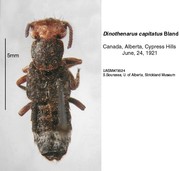Species Details
Dinothenarus capitatus
University of Alberta E.H. Strickland Entomological Museum Read more about this collection »
SeasonalityThe only D. capitatus specimen in the Strickland Museum was collected in June.
IdentificationThe size of an adult D. capitatus ranges between 12.5 to 15mm (Downie and Arnett, 1996). The adult D. capitatus is quickly recognized by a densely punctate head with dark yellow color. The temples are almost straight behind the eye (Smetana and Davies, 2000). The color of the head contrasts with the dark brown pronotum and abdomen. The pronotum is covered with patches of yellow setae among the black setae (Downie and Arnett, 1996). The legs are mostly dark brown with some dark yellow area on dorsal side of femur and tibia. The antennae are slightly darker than the head. The densely punctate elytra are covered with widely scattered smooth spots with dark pubescent (Downie and Arnett, 1996). Abdominal terga (dorsal abdominal segment) 2-4 with H-shaped velvety spot at middle and segment 5-6 with gray pubescence (Downie and Arnett, 1996). The gray pubescence is also present on nearly all sternites (ventral abdominal segment). Tarsal formula 5-5-5 and 11 antenomeres with the last one transverse. The last segment of the labial palp is narrow and fusiliform (Downie and Arnett, 1996).
Scientific Name
Dinothenarus capitatus
Habitat
Found on dung, carrion and fungus of various kinds in the northern forests (Arnett and Thomas, 2000).
Seasonality
The only D. capitatus specimen in the Strickland Museum was collected in June.
Identification
The size of an adult D. capitatus ranges between 12.5 to 15mm (Downie and Arnett, 1996). The adult D. capitatus is quickly recognized by a densely punctate head with dark yellow color. The temples are almost…
The size of an adult D. capitatus ranges between 12.5 to 15mm (Downie and Arnett, 1996). The adult D. capitatus is quickly recognized by a densely punctate head with dark yellow color. The temples are almost straight behind the eye (Smetana and Davies, 2000). The color of the head contrasts with the dark brown pronotum and abdomen. The pronotum is covered with patches of yellow setae among the black setae (Downie and Arnett, 1996). The legs are mostly dark brown with some dark yellow area on dorsal side of femur and tibia. The antennae are slightly darker than the head. The densely punctate elytra are covered with widely scattered smooth spots with dark pubescent (Downie and Arnett, 1996). Abdominal terga (dorsal abdominal segment) 2-4 with H-shaped velvety spot at middle and segment 5-6 with gray pubescence (Downie and Arnett, 1996). The gray pubescence is also present on nearly all sternites (ventral abdominal segment). Tarsal formula 5-5-5 and 11 antenomeres with the last one transverse. The last segment of the labial palp is narrow and fusiliform (Downie and Arnett, 1996).
Life History
Like all the members of the Staphilinini tribe, D. capitatus possesses paired eversible defensive glands located at the tip of the abdomen (Arnett and Thomas, 2000). If threatened, D. capitatus brings its last…
Like all the members of the Staphilinini tribe, D. capitatus possesses paired eversible defensive glands located at the tip of the abdomen (Arnett and Thomas, 2000). If threatened, D. capitatus brings its last abdominal segment in contact with the threat and releases a chemical mixture (often mixed with defecation) to repell it.
Conservation
Rare in North America from Newfoundland to British-Columbia (Arnett and Thomas, 2000).
Diet Info
No information available.
Range
In North America, from Newfoundland to British-Columbia (Arnett and Thomas, 2000).
References
Author
Newton, A. E., M. K. Thayer, J. S. Ashe and D. S. Chandler
Title
American beetles.
Publication Date
2001
Pages
272-418
Author
Smetana, A. and A. Davies
Title
Reclassification of the North Temperate Taxa Associated with Staphylinus Sensu Lato, Including Comments on Relevant Subtribes of Staphylinini (Coleoptera: Staphylinidae).
Publication Date
2000
Series Title
American Museum Novitates
Pages
1-88
Author
Downie, N. M. and R. H. Arnett
Title
The beetles of northeastern North America.
Publication Date
1996
Volume
1
Pages
880 pp.
Specimen Information
There are 3 specimens of this Species.
UASM73524 - Dinothenarus capitatus
University of Alberta E.H. Strickland Entomological Museum
Place CollectedCanada: Alberta, Cypress Hills
Collected ByCarr, F. S.
Date Collected1921-06-24
UASM333894 - Dinothenarus capitatus
University of Alberta E.H. Strickland Entomological Museum
Place CollectedCanada: Alberta, Dixonville
Collected ByPyper, M.
Date Collected2006/2007
UASM333895 - Dinothenarus capitatus
University of Alberta E.H. Strickland Entomological Museum
Place CollectedCanada: Alberta, Dixonville
Collected ByPyper, M.
Date Collected2006/2007



